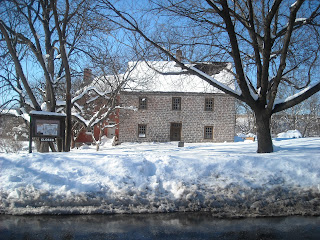 One thing I love about the area of central/western Maryland where I live is the abundance of history. As I walk in the historic district in my town, I pass town homes, churches, and shops, that were built as far back as 1742 on down into the early 1900s.
One thing I love about the area of central/western Maryland where I live is the abundance of history. As I walk in the historic district in my town, I pass town homes, churches, and shops, that were built as far back as 1742 on down into the early 1900s.There is one such place that I'd like to share, a place you most likely have never heard of.
 Built sometime in 1758, Schifferstadt is the one of the oldest and most treasured historic buildings in Frederick, Maryland. It is one of the best examples of early Colonial German Architecture in the country, and as a home built as refuge. Settlers in central and western Maryland were in fear of attacks by the French and their Indian allies during the French and Indian War.
Built sometime in 1758, Schifferstadt is the one of the oldest and most treasured historic buildings in Frederick, Maryland. It is one of the best examples of early Colonial German Architecture in the country, and as a home built as refuge. Settlers in central and western Maryland were in fear of attacks by the French and their Indian allies during the French and Indian War.'Joseph Bruner, a German immigrant and his family left their village of Klein Schifferstadt in 1729 in hopes of gaining independence, including the right to own property and build a home in the "New Land." He purchased 303 acres of virgin timber in 1746, cleared and farmed the land, and built a modest wood structure for his family home. Joseph Bruner named his farm Schifferstadt after his hometown in the Palatinate region of South Western Germany.
Joseph's eighth and youngest son, Elias Bruner, bought the farm from his father in 1753, and built the stone farmhouse in 1758 that we know today as Schifferstadt. Although its exterior and interior have been altered over the years, Schifferstadt maintains many original architectural features.'
Quoted from the Frederick County Landmarks Foundation website
http://www.frederickcountylandmarksfoundation.org/fclf_schiffgen.htmlA few weeks ago, my husband and I took a walk on the grounds. The first thing I noticed was the exceptional craftmanship of the laying and chinking of the sand stones. The house has a warm feeling to it. The door inviting to all guests. Inside one finds fireplaces with built in cupboards alongside them, broad windows that allow plenty of light to enter, a winder staircase, and a vaulted cellar. In spring and summer there are gardens of flowers and vegetables.

Schifferstadt is now a historical museum. If you ever in this neck of the woods, Schifferstadt is located 50 minutes from Baltimore and Washington, DC and 30 minutes from Gettysburg, PA, and only open on Saturday afternoons, April through October.

Lovely! This one's right in my old backyard. As always I wish I could seal myself up in an envelope (or maybe a small box) and mail myself back east to these historic places. Wonder if they'd notice? :)
ReplyDeleteRita, I enjoyed the tour of this historical Maryland home. I've never been to your area, so it's great to be able to visit over the internet.
ReplyDeleteRita--This blew me away in that you could easily take these buildings, pick them up and move them to the Mohawk Valley where they'd become Ft. Klock, Indian Castle Church, or some of the Palatine German homes/forts built in the the mid-1700's! Beautiful--thank you!
ReplyDelete